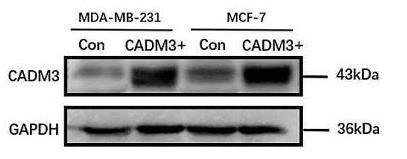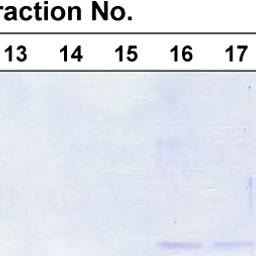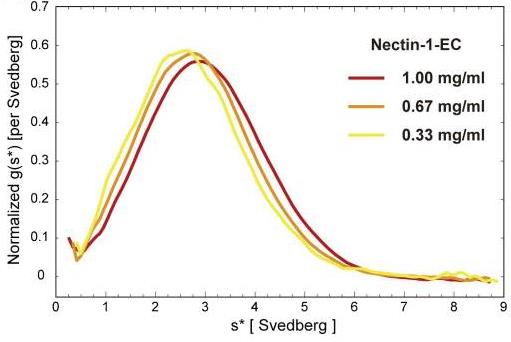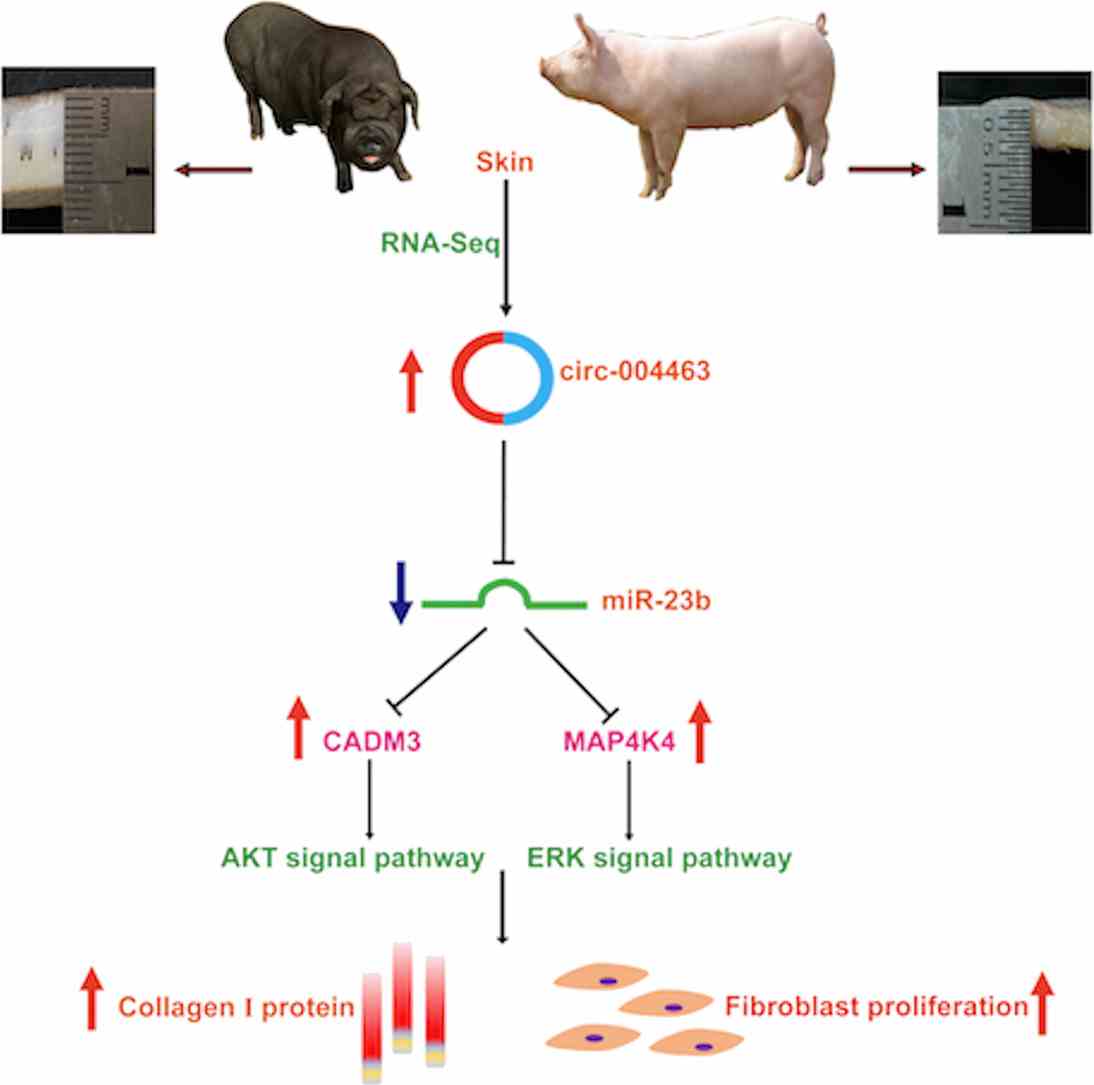Recombinant Human CADM3 protein(Met1-His330), His-tagged
| Cat.No. : | CADM3-2184H |
| Product Overview : | Recombinant Human CADM3 isoform 2 (short isoform) (NP_001120645.1) (Met 1-His 330) was expressed in HEK293, with a polyhistidine tag at the C-terminus. |
| Availability | March 15, 2025 |
| Unit | |
| Price | |
| Qty |
- Specification
- Gene Information
- Related Products
- Case Study
- Application
- Download
| Species : | Human |
| Source : | HEK293 |
| Tag : | His |
| Protein Length : | Met1-His330 |
| Form : | Lyophilized from sterile PBS, pH 7.4. Normally 5 % - 8 % trehalose, mannitol and 0.01% Tween80 are added as protectants before lyophilization. |
| Molecular Mass : | The recombinant human CADM3 consists of 317 amino acids and predictes a molecular mass of 35.1 kDa. In SDS-PAGE under reducing conditions, the apparent molecular mass of rh CADM3 is approximately 39-41 kDa due to glycosylation. |
| Endotoxin : | < 1.0 EU per μg of the protein as determined by the LAL method |
| Purity : | > 95 % as determined by SDS-PAGE |
| Storage : | Samples are stable for up to twelve months from date of receipt at -20°C to -80°C. Store it under sterile conditions at -20°C to -80°C. It is recommended that the protein be aliquoted for optimal storage. Avoid repeated freeze-thaw cycles. |
| Reconstitution : | It is recommended that sterile water be added to the vial to prepare a stock solution of 0.2 ug/ul. Centrifuge the vial at 4°C before opening to recover the entire contents. |
| Gene Name | CADM3 cell adhesion molecule 3 [ Homo sapiens ] |
| Official Symbol | CADM3 |
| Synonyms | CADM3; cell adhesion molecule 3; IGSF4B, immunoglobulin superfamily, member 4B; BIgR; FLJ10698; Necl 1; NECL1; nectin like 1; SynCAM3; TSLL1; TSLC1-like 1; nectin-like 1; TSLC1-like protein 1; nectin-like protein 1; brain immunoglobulin receptor; synaptic cell adhesion molecule 3; immunoglobulin superfamily member 4B; immunoglobulin superfamily, member 4B; dendritic cell nectin-like protein 1 short isoform; IGSF4B; Necl-1; synCAM3; |
| Gene ID | 57863 |
| mRNA Refseq | NM_001127173 |
| Protein Refseq | NP_001120645 |
| MIM | 609743 |
| UniProt ID | Q8N126 |
| ◆ Recombinant Proteins | ||
| CADM3-644H | Active Recombinant Human CADM3, Fc-tagged, Biotinylated | +Inquiry |
| CADM3-113H | Recombinant Human CADM3 Protein, His-tagged | +Inquiry |
| Cadm3-3301M | Recombinant Mouse Cadm3 protein(Met1-His328), His-tagged | +Inquiry |
| CADM3-745R | Recombinant Rat CADM3 Protein, His (Fc)-Avi-tagged | +Inquiry |
| CADM3-186H | Recombinant Human CADM3 Protein, His-tagged | +Inquiry |
| ◆ Cell & Tissue Lysates | ||
| CADM3-738RCL | Recombinant Rat CADM3 cell lysate | +Inquiry |
| CADM3-2275MCL | Recombinant Mouse CADM3 cell lysate | +Inquiry |
| CADM3-2556HCL | Recombinant Human CADM3 cell lysate | +Inquiry |
Case 1: Ren H, et al. BMC Cancer. 2024
Cancer, especially breast cancer, is not well understood, and Cell adhesion molecule 3 (CADM3) is expected to be a breakthrough for research. Researchers looked into CADM3's role using data from The Cancer Genome Atlas and actual patient samples. They found that breast cancer tissues had less CADM3 than normal ones, and higher levels of CADM3 were linked to better patient outcomes. CADM3 seemed to interact with certain immune cells and was tied to the MAPK pathway, affecting cell growth and movement. Essentially, higher CADM3 levels could mean a better prognosis for breast cancer patients.

Fig1. Protein expression of CADM3 in 8 cases of human BC and its adjacent pairs of normal tissues.

Fig2. The overexpression efficiency of CADM3 in MCF-7 and MDA-MB-231 cell lines verified by WB.
Case 2: Narita H, et al. J Biol Chem. 2011
In multicellular creatures, cells stick together using cell adhesion molecules. Nectins, a type of these molecules, are like immune system proteins that help cells adhere to each other, crucial for organizing tissues. They first form pairs on the same cell surface, then join with pairs on nearby cells. Earlier research suggested that their first and second domains handle this pairing, but more insight into how nectin works requires understanding its structure. This study unveiled the first crystal structure of nectar-1's full external area, showing a V-shaped pair through its first domain. Alterations in four key residues in this domain disrupted its ability to pair within and between cells, affecting adhesive actions.

Fig1. Binding of nectin-1-EC to Nef-3.

Fig2. G(s*) analysis of nectin-1-EC and nectin-1-EC-4mut by sedimentation velocity.
Human CADM3, known as Cell Adhesion Molecule 3, is a key player in helping cells stick together without needing calcium. It's also considered a tumor suppressor gene. Researchers explore its role in cell adhesion and its potential in fighting tumors. In the lab, recombinant versions of CADM3 are used to see how it binds with other proteins, including ones that might control the way cell junctions are formed. It's also looked at for its role in conditions like neurological disorders and cancer, offering a window into how cells communicate and stick together.
In the industry, recombinant CADM3 is important for creating new treatments, especially for diseases linked to cell adhesion issues and certain cancers. Made in HEK293 cells with an easy-to-track His tag, it becomes a crucial part of devising new drugs and researching how adhesion molecules work. This production ensures consistent reagents for experiments, helping scientists get reliable results. Plus, the recombinant protein helps develop tools and antibodies necessary to spot CADM3 in biological samples, aiding in the research of its functioning and related diseases.

Fig1. Circ004463 promotes fibroblast proliferation and collagen I synthesis by sponging miR-23b and regulating CADM3/MAP4K4 via activation of AKT/ERK pathways. (Qin Zou, 2023)
Not For Human Consumption!
Inquiry
- Reviews
- Q&As
Ask a Question for All CADM3 Products
Required fields are marked with *
My Review for All CADM3 Products
Required fields are marked with *
Inquiry Basket


